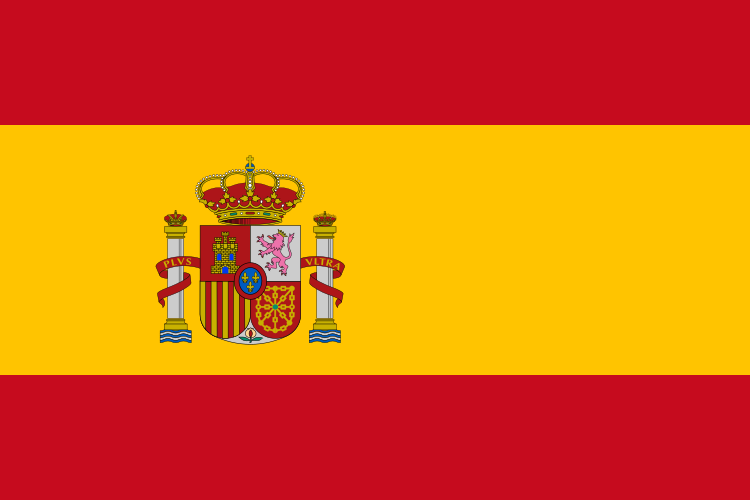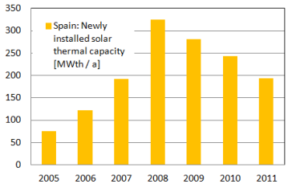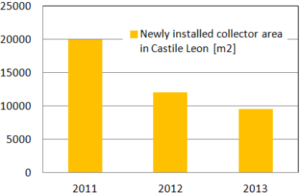Spain: “Most of these companies will survive thanks to internationalisation”
December 16, 2013
Despite the seemingly never-ending recession in Spain, the solar thermal sector doesn’t throw in the towel. The sector is mainly dependent on the Technical Building Code, CTE, which mandates the installation of solar hot water systems in new structures and buildings undergoing major renovation. The burst of the housing bubble collapsed the construction market. Only 44,000 new houses were built in 2012 compared to 800,000 in 2006. Still, the economy shows the first signs of recovery, and the Spanish Solar Thermal Industry Association, ASIT, has been eager to find alternative markets and incentives that could improve the current situation.
Since the financial crisis, the Spanish market has been more than just cut in half: Whereas the solar thermal capacity installed in 2008 was still 303 MWth, market volume is down to 142 MWth in 2013, according to ASIT’s first estimations. The major reason for the strong decline has been the industry’s great dependency on the building standard. According to ASIT, 83 % of the systems in 2012 were installed due to CTE regulations for new buildings, but only 15 % were set up thanks to several regional incentives. Barely 2% of the total market was not dependent on subsidies or compulsory schemes at all. Retrofitting hot water systems in existing buildings has had almost no effect on the solar market, “because is it rather difficult to integrate a solar water heating system in an old building or have all the owners agree to the installation in a block of flats,” Pascual Polo, Secretary General of ASIT, explains.
Manufacturers seem to be adapting better than expected. “During the first years of the crisis, many producers halted their operations altogether. However, most of them have been resisting this trend over the last two years,” Polo says. According to the secretary general, more than 50% of the total solar thermal collector production in Spain is currently being exported – whereas previously, most of the domestic production was sold on the national market. “That means that most of these companies will survive thanks to internationalisation,” Polo concludes.
The economy has also been showing the first signs of recovery this year. In November, the unemployment rate has gone down for the first time since 1989, and 2014 could be the year that puts an end to the crisis in the housing market. “During the first half of 2013, we carried out a survey which showed that the total number of installed systems is still decreasing, but at a lower rate,” Polo analyses. “Over the last five years, the annual decrease in new solar thermal systems was between 15 and 20%. We expect a decline of only 10% this year, which corresponds to some 200,000 m2 of new collectors.” According to Polo, some regions, such as Andalusia, are subsidising solar water heating systems and expect to keep their schemes up and running over the next years. “Andalusia saw around 30,000 m2 of collector area installed in 2012, while 2013’s number is expected to even reach 50,000 m2.” The incentive offered in Andalusia consists of a direct subsidy of between 20 and 40% of the system costs. Some other regions, such as the Basque Country and Valencia, have similar schemes.
In November 2013, the Spanish Ministry of Industry, Energy and Tourism additionally approved a scheme called Nuevo Programa de Ayudas para la Rehabilitación Energética de Edificios existentes del sector Residencial (translated as New Programme Supporting the Energy Efficiency of Existing Residential Buildings). The programme offers zero-interest loans and EUR 125 million for allocation as credits on energy efficiency measures, including solar thermal installations. “It helps, but it is not enough,” Polo points out. “The problem with the loans is that they cannot be combined with some of the other incentives.”
So, regional incentives, soft loans and the CTE norm seem insufficient to improve the situation on the solar thermal market. ASIT’s hopes are still pinned on the Renewable Energy Plan, PER, approved in 2011, which includes an incentive scheme for renewable heat called ICAREN.
The basic idea behind ICAREN is that Energy Service Companies (ESCOs) receive an incentive for every kWh of renewable heat that they sell to their customers. “The current government is extremely reluctant to approve anything that resembles a feed-in tariff,” Polo explains. “The cost of this scheme will be something around EUR 50 million per year, which is nothing compared to the billions invested in other technologies, such as PV or wind.” Despite the government’s reluctance, ASIT is still fighting and pushing for the government to approve ICAREN. “We are not throwing in the towel. The scheme has still a chance to be approved over the coming months,” the head of ASIT confirms. “Instead of the industry ministry, we are now in contact with some other offices, such as the Ministry of Environment,” Polo says.
More information:
ASIT: http://www.asit-solar.com/
Nuevo Programa de Ayudas para la Rehabilitación Energética de Edificios existentes del sector Residencial: http://www.buildup.eu/news/38331


